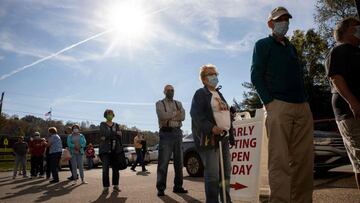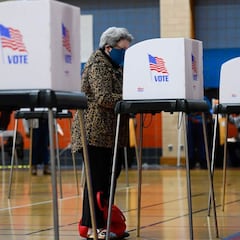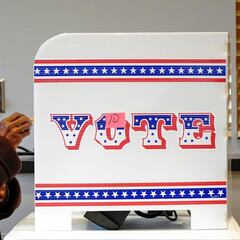USA Election 2020: what is voter suppression?
Difficult to define and even harder to detect, what exactly is voter suppression, is it taking place in the US and what can you do about it?

Voter suppression has existed as long as democracy itself, but it’s important to be aware that whilst votes can be suppressed in some cities, in some districts, of some states; as Myrna Perez speaking to Vox wisely reminds us, “the vast majority of Americans are going to have a completely uneventful voting experience.”
What is voter suppression?
Voter suppression is defined as the attempt to depress participation or turnout of voters in an election. The term is used to describe when a party or individual is taking steps to deliberately reduce access to the ballot, usually targeting specific sections of society. What it this means in real terms is far more complicated.
How does voter suppression happen?
The US has a decentralised voting system; meaning that from absentee voting laws right down to the training given to poll workers, practically everything is governed at state level. The advantage of this system is that it’s pretty tricky to maliciously interfere on a grand scale with US elections. As the voting processes vary so wildly from state to state, it would involve hacking thousands of systems both electronic and analogue. The disadvantage is that, put simply, the complexity and variety of voting systems in the US makes it harder for citizens to participate.
There are two key ways of suppressing voters. One is to make it practically difficult for certain people to vote. For example, closing down polling stations near to certain neighbourhoods and not others or under-resourcing polling stations so that lines to vote are hours long.
Long voting lines are voter suppression. But we’re not going to let that stop us.
— Cori Bush (@CoriBush) October 24, 2020
For everyone standing in line, braving the elements, and making sure their votes are cast—thank you.
They don’t want us to vote, but we’re not going to let them win.
In 1890’s America, poll taxes were introduced requiring eligible voters to pay a fee before casting their ballot, forcibly disenfranchising the working classes from participating in the democratic system. Around the same time, literacy tests were also introduced which directly oppressed poor African-American voters in Southern states. African-American literacy rates lagged far behind white literacy rates until around 1940. The Voting Rights Act only ended literacy tests across the whole country in 1970.
A new investigation by VICE News this month found that 21,000 Election Day polling places have been eliminated going into the 2020 election, which it says could end up disproportionately affecting poor, young and non-white voters.
VOTER SUPPRESSION ON AN ENORMOUS SCALE...The US Eliminated Nearly 21,000 Election Day Polling Locations for 2020 - VICE https://t.co/TwvMtttmRD
— bettemidler (@BetteMidler) October 23, 2020
The second method of voter suppression is more subtle and can be harder to detect. It involves discouraging, often by inciting either fear or apathy, a sector of the electorate from wanting to participate in the vote.
In 2020 Donald Trump has taken fairly concerted efforts to discredit, without proof, the integrity of mail-in voting knowing that his discouraging message would hit more Biden fans than Trump voters. The president has also been encouraging his supporters to go and watch at polling stations, potentially setting up physically intimidating situations for Democratic voters.
Legal attempts at voter suppression
Voter suppression mostly happens legally, when lawmakers pass legislation that make voting more difficult thus affecting either the ability or motivation to vote for certain groups.
It became easier for states to take control of their own voting laws in 2013 with the Shelby County, Alabama v. Holder case. The Supreme Court rolled back the Department of Justice’s ability to prevent laws being made that carry an unfair burden to voting access in states that already carry a history of voter suppression (like Alabama). It meant that any new voting rights laws being passed no longer required federal approval or assessment of the law’s effect on voters.
In Donald Trump’s first year of office, he passed no less than 99 bills across 31 states that moved to restrict access to registration and voting.
For example, Montana’s house and senate passed a bill that would prevent members of the public from helping others to vote absentee ballots by collecting and delivering their completed ballots. Since then, several Native American groups argued that they rely on ballot collection efforts such as these to vote, given that much of the indigenous population live on remote reservations. In September this year the bill was overturned.
Voter purging and voter suppression
In late 2018, aggressive voter purging was carried out in both Wisconsin and Georgia, effectively removing hundreds of thousands of registered voters from the rolls in one go. Voter purging can be a useful way to keep the voting roll accurate, when it’s practiced carefully to remove people who move house or die for instance. However, critics claim that practiced too aggressively it essentially penalises people for previously not voting.
Voter ID laws and voter suppression
To understand how these types of seemingly small obstacles may disproportionately affect one demographic and not another, take a look at voter ID laws.
Texas allows voters to use a handgun license as identification to vote but not a student ID from a state university. More than 80% of handgun licenses issued to Texans in 2018 went to white Texans, while more than half of the students in the University of Texas system are racial or ethnic minorities, according to The Brennan Center for Justice.
It’s been predicted by the American Civil Liberties Union that over 21 million US citizens, or 11% of potential voters, do not have government-issued photo identification. This is because ID cards aren’t always accessible for everyone; the ID itself can be costly and even when IDs are free, applicants must incur other expenses to obtain the required documents that are needed to get an ID. This can be a significant burden on people in lower-income communities.
Voter registration laws and voter suppression
2017 saw Georgia’s governor Brian Kemp succeeded in holding up the registrations of 53,000 voters under an “exact match” law, where an error as tiny as a hyphen or comma in the wrong place could mean obstacles for the registrant in voting. In 2018, 80% of Georgia voters blocked by the state’s “exact match” law were people of colour in 2018, according to The Brennan Center.
The Associated Press in late 2019 released details of an audio recording of top Trump advisor Justin Clark appearing to admit that the practice of voter suppression has always been carried out by his party.
“Traditionally it’s always been Republicans suppressing votes in places,” Clark said. “Let’s start protecting our voters. We know where they are...let’s start playing offense a little bit. That’s what you’re going to see in 2020. It’s going to be a much bigger program, a much more aggressive program, a much better-funded program.”
Asked about the remarks by AP, Clark said he was referring to false accusations that the GOP engages in voter suppression.
It’s not all bad news, though. Fifteen state legislatures passed bills in 2017 to expand access to voting, including upgrading absentee voting procedures, improving the process for registrations and streamlining the voter ID laws.
Illegal attempts at voter suppression
Voter intimidation and poll watching
This year, there has been significant attention on Trump’s calls to his supporters to "go into the polls and watch very carefully." According to Politico, Trump supporters have attempted to monitor or even interrupt early voting in several places, including in Philadelphia in September. Election staff said that law enforcement escorted a Trump campaign staffer out of a satellite election office because he was not allowed to be there to watch people request or turn in mail ballots in person.
To clarify, poll watching (or poll challenging) is perfectly legal and volunteers and party representatives routinely observe polling places in the US. The NCSL says that the role of a poll watcher is to ensure that their party has a fair chance of winning an election by closely monitoring election administration and maybe keeping track of voter turnout for their party.
Poll watchers are not supposed to interfere in the electoral process apart from reporting issues to polling place authorities and party officials.
What's more, not just anyone can be a poll watcher. Many states require that poll watchers meet certain qualifications and register in advance, as opposed to simply showing up unannounced.
The law prohibits any conduct that threatens, intimidates or pressures a person to vote, or not vote, or vote in a certain way. This could include a myriad of behaviours, but for instance questioning someone’s voter rights by asking personal questions about their criminal record or citizenship is a federal crime. Also considered voter intimidation is the spreading of false information about voting laws and requirements.
Voter suppression and foreign interference
Earlier this month, a blatant but somewhat unsophisticated voter intimidation and suppression attempt came to light when registered Democrats received menacing emails from the official Proud Boys account. The emails, which contained personal information of the recipients, threatened that if they didn’t vote for Trump, “we will come after you”. US government maintains that the emails stem from voter registration information that was illegally obtained by Russia and Iran.
The Proud Boys, a far-right extremist group, also recently received significant media attention since president Trump refused to denounce them at the first presidential debate.
What can I do to avoid my vote being suppressed?
The best thing you can do as an individual is be prepared and be well informed about the specific voting laws that apply to you. No two states have exactly the same rules on voter laws, so be aware of which measures affect you, and which don’t.
For example felons’ voting rights vary wildly state-to-state. Depending on where you live, felons can lose their right to vote for life automatically, but in some states they only lose the right to vote during incarceration, or in some states like Maine and Vermont, people with felony convictions have the same voting rights as everyone else.
Ensure that you read the instructions for filling in your ballot very carefully and only mark it as instructed. If voting by mail, take extra care with instructions as they vary hugely between states and send it back as soon as possible.
When it comes to voter intimidation, remember that you have the right not to be harassed about which candidate you’ve voted for or even your right to vote in the first place.
Related stories
If you or someone else is being harassed or threatened at the polls; you should take the following three steps.
- Report the incident to a poll worker.
- Call and report it to the Election Protection Hotline (1-866-OUR-VOTE) or the US Department of Justice voting rights hotline (1-800-253-3931).
- Contact your state board of elections. In some cases, a poll worker may call local authorities to remove the individual in question.
More advice on safe voting in the US election 2020.


